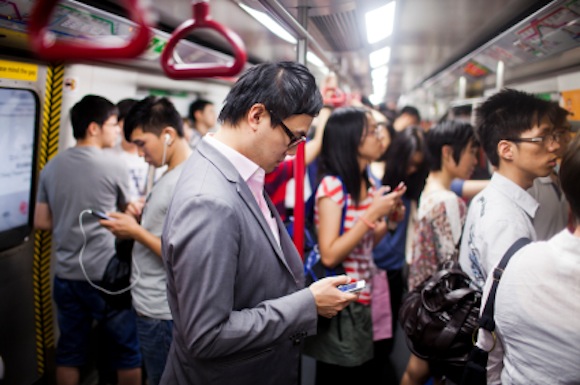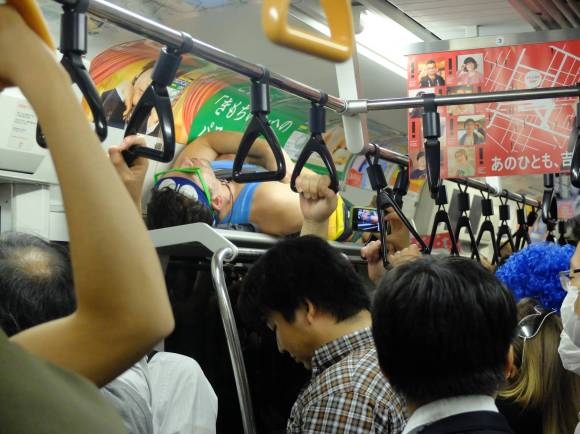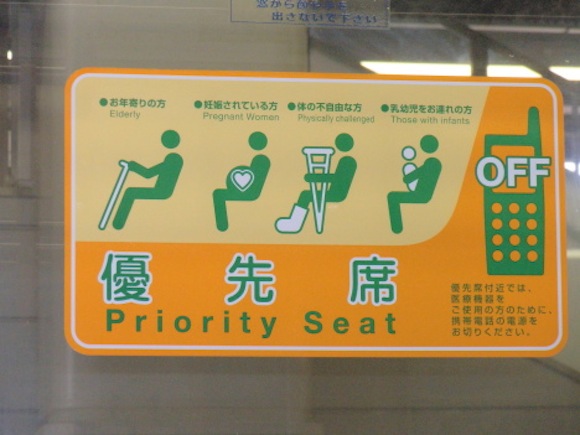
There are seemingly endless things one is not allowed to do on Japanese trains: eat or drink, put on makeup, talk on the phone, take up too much room. Most of these are sensible if strict, making life more pleasant for everybody in a jam-packed carriage. There’s one rule that’s a bit more unusual, though, and that’s the requirement that you switch your phone off near the priority seats.
Mobile phones can interfere with pacemakers, ran the conventional wisdom. So to give passengers with medical equipment a safe haven from electronic interference, most train companies asked passengers to switch phones off completely in certain areas. This summer, rail companies in Kansai more or less ditched that policy, saying it’s no longer necessary. Tokyo, meanwhile, shows no signs of changing the rules.
▼ Phone-free carriages: also great for people who hate technology.
The ‘power off ‘ rule stems from a 2005 recommendation from the Ministry of Internal Affairs and Communications. Rail companies’ implementation of it varies, however: some ask that passengers turn phones off near priority seating; other companies have separate carriages; on some lines, all carriages are designated ‘power off’.
When 2G mobile phones were phased out, though, the danger posed to people with pacemakers all but vanished. Until 2012, the ministry recommended that phones be kept 22cm from a pacemaker – in a crowded train, there was a reasonable possibility of that being breached. Now, the recommendation is 3cm. So in the Kansai area, rail companies dropped the ‘power off’ rule this July, except for at busy times.
▼ Busy times are busy.
In Kantō, however, the area further east including Tokyo that shares a centuries-old rivalry with Kansai, rail companies say they have no intention of relaxing the rules. Kantō’s urban trains are famously crowded, so perhaps that’s part of the thinking, although JR East and Tokyo Metro both cited customer unease as the reason:
“Passengers with pacemakers are [still] uneasy about the use of mobile phones.”
The government, however, has been clear that the old ‘power off’ recommendations were for 2G service, and are not necessary now that it’s no longer used. It seems like there’s a case for educating people that the risks have changed, rather than keeping the rules the same because of passengers’ misconceptions.
▼ Spotted: a phone with an actual antenna.
Source: IT media news
Top image: yumekata




 10 times Japanese train passengers aren’t so polite【Survey】
10 times Japanese train passengers aren’t so polite【Survey】 Man boards women-only carriage on Japanese train, gets his glasses knocked off【Video】
Man boards women-only carriage on Japanese train, gets his glasses knocked off【Video】 Yamanote Line train temporarily suspended after carriage fills with smoke in Tokyo
Yamanote Line train temporarily suspended after carriage fills with smoke in Tokyo What to do if your phone battery dies when using a mobile transit pass on a Japanese train
What to do if your phone battery dies when using a mobile transit pass on a Japanese train Rugby World Cup fans slammed for singing anthems, forming human pyramids on Japanese trains
Rugby World Cup fans slammed for singing anthems, forming human pyramids on Japanese trains Brand-new all-Harry Potter theme park could be opening in Tokyo
Brand-new all-Harry Potter theme park could be opening in Tokyo Cup Noodle tries an authentic Jiro-style ramen, but something’s not quite right
Cup Noodle tries an authentic Jiro-style ramen, but something’s not quite right What did Shibuya really look like after the crowds on New Year’s Day?
What did Shibuya really look like after the crowds on New Year’s Day? Hayao Miyazaki says Happy New Year to Studio Ghibli fans with new art for Year of the Horse
Hayao Miyazaki says Happy New Year to Studio Ghibli fans with new art for Year of the Horse One of Tokyo’s best hot spring complexes is closing for good
One of Tokyo’s best hot spring complexes is closing for good Ginza hotel serves up one of the best breakfasts in Tokyo
Ginza hotel serves up one of the best breakfasts in Tokyo You can now visit a recreation of Evangelion’s Tokyo-3 and live there in miniature form in【Pics】
You can now visit a recreation of Evangelion’s Tokyo-3 and live there in miniature form in【Pics】 Starbucks Japan unveils new Sakura Frappuccino for cherry blossom season 2025
Starbucks Japan unveils new Sakura Frappuccino for cherry blossom season 2025 Kansai-exclusive takoyaki Cup Noodle lives up to half of the expectations its name produces
Kansai-exclusive takoyaki Cup Noodle lives up to half of the expectations its name produces Evangelion original anime studio Gainax is now completely dissolved, Eva’s creator mourns ruined friendships
Evangelion original anime studio Gainax is now completely dissolved, Eva’s creator mourns ruined friendships Starbucks Japan ready to get Year of the Horse started with adorable drinkware and plushies【Pics】
Starbucks Japan ready to get Year of the Horse started with adorable drinkware and plushies【Pics】 7 great places to see Mt. Fuji from without having to climb it
7 great places to see Mt. Fuji from without having to climb it Cyberpunk anime meets traditional culture in Ghost in the Shell gold leaf Japanese changing screens
Cyberpunk anime meets traditional culture in Ghost in the Shell gold leaf Japanese changing screens Hello Kitty Choco Egg figures are an adorable trip through three periods of Japanese pop culture【Pics】
Hello Kitty Choco Egg figures are an adorable trip through three periods of Japanese pop culture【Pics】 We found possibly the quietest Japanese-style hotel in Tokyo’s bustling Shinjuku district
We found possibly the quietest Japanese-style hotel in Tokyo’s bustling Shinjuku district 7-Eleven Japan’s ramen-cooking robot whipped us up a bowl of noodles【Taste test】
7-Eleven Japan’s ramen-cooking robot whipped us up a bowl of noodles【Taste test】 Sumo Sanrio! Hello Kitty and pals team up with Japan Sumo Association for new merch【Pics】
Sumo Sanrio! Hello Kitty and pals team up with Japan Sumo Association for new merch【Pics】 Japan’s oldest largetooth sawfish in captivity back on display in Mie Prefecture
Japan’s oldest largetooth sawfish in captivity back on display in Mie Prefecture More Than a Capsule Stay: Why Solo Travelers Choose “global cabin Yokohama Chinatown”
More Than a Capsule Stay: Why Solo Travelers Choose “global cabin Yokohama Chinatown” 7-Eleven Japan starts new temporary luggage storage service in over 300 branches
7-Eleven Japan starts new temporary luggage storage service in over 300 branches Disillusionment at Tsukiji’s tourist-target prices led us to a great ramen restaurant in Tokyo
Disillusionment at Tsukiji’s tourist-target prices led us to a great ramen restaurant in Tokyo Starbucks teams up with 166-year-old Kyoto doll maker for Year of the Horse decorations【Photos】
Starbucks teams up with 166-year-old Kyoto doll maker for Year of the Horse decorations【Photos】 Tokyo considering law requiring more trash cans following litter increase in heavily touristed area
Tokyo considering law requiring more trash cans following litter increase in heavily touristed area Tokyo’s Tsukiji sushi neighborhood asks tour groups to stay away for the rest of the month
Tokyo’s Tsukiji sushi neighborhood asks tour groups to stay away for the rest of the month Tokyo event lets you travel back in time, for free, to celebrate 100 years since Showa era start
Tokyo event lets you travel back in time, for free, to celebrate 100 years since Showa era start Sanrio theme park in Japan announces plans to expand into a Sanrio resort
Sanrio theme park in Japan announces plans to expand into a Sanrio resort Japan may add Japanese language proficiency, lifestyle classes to permanent foreign resident requirements
Japan may add Japanese language proficiency, lifestyle classes to permanent foreign resident requirements Stamina-destroying “Paralysis Noodles” are Tokyo’s newest over-the-top ramen innovation
Stamina-destroying “Paralysis Noodles” are Tokyo’s newest over-the-top ramen innovation Survey asks foreign tourists what bothered them in Japan, more than half gave same answer
Survey asks foreign tourists what bothered them in Japan, more than half gave same answer Japan’s human washing machines will go on sale to general public, demos to be held in Tokyo
Japan’s human washing machines will go on sale to general public, demos to be held in Tokyo Japan’s deadliest food claims more victims, but why do people keep eating it for New Year’s?
Japan’s deadliest food claims more victims, but why do people keep eating it for New Year’s? We deeply regret going into this tunnel on our walk in the mountains of Japan
We deeply regret going into this tunnel on our walk in the mountains of Japan Studio Ghibli releases Kodama forest spirits from Princess Mononoke to light up your home
Studio Ghibli releases Kodama forest spirits from Princess Mononoke to light up your home Major Japanese hotel chain says reservations via overseas booking sites may not be valid
Major Japanese hotel chain says reservations via overseas booking sites may not be valid Put sesame oil in your coffee? Japanese maker says it’s the best way to start your day【Taste test】
Put sesame oil in your coffee? Japanese maker says it’s the best way to start your day【Taste test】 No more using real katana for tourism activities, Japan’s National Police Agency says
No more using real katana for tourism activities, Japan’s National Police Agency says Starbucks Japan reveals new sakura drinkware collection, inspired by evening cherry blossoms
Starbucks Japan reveals new sakura drinkware collection, inspired by evening cherry blossoms Updated cherry blossom forecast shows extra-long sakura season for Japan this year
Updated cherry blossom forecast shows extra-long sakura season for Japan this year Mobile battery fire breaks out on Tokyo’s main commuter line
Mobile battery fire breaks out on Tokyo’s main commuter line Seats descend from ceiling on Japanese train to provide extra comfort for passengers【Video】
Seats descend from ceiling on Japanese train to provide extra comfort for passengers【Video】 Japanese train conductor flips off rail fan photographer, prompts apology from JR
Japanese train conductor flips off rail fan photographer, prompts apology from JR To sit or not to sit? Linguistic and societal debate on Japanese train seats for the elderly
To sit or not to sit? Linguistic and societal debate on Japanese train seats for the elderly Can you guess where this amazing Japanese commuter train is hiding some extra seats? 【Video】
Can you guess where this amazing Japanese commuter train is hiding some extra seats? 【Video】 New Japanese train etiquette point arises from high temperatures and high handy fan sales
New Japanese train etiquette point arises from high temperatures and high handy fan sales
Leave a Reply